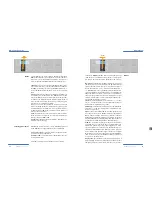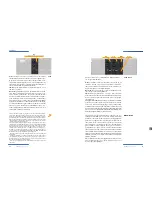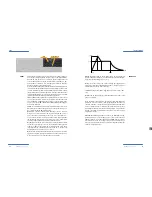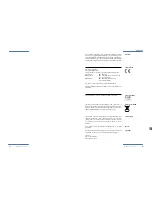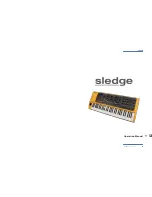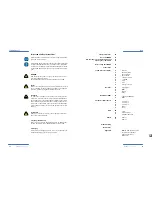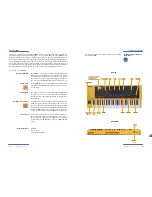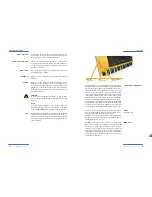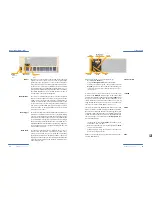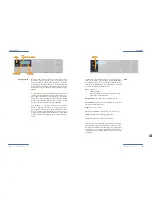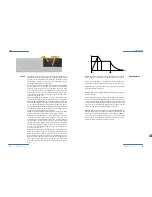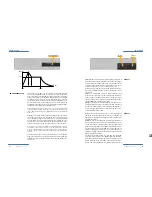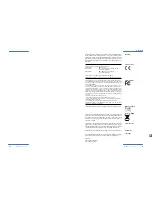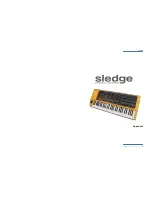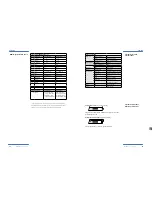
SLEDGE
by Studiologic®
SLEDGE
by Studiologic®
42
43
E
Oscillator 1
Osc 2 / Osc3 / Mixer / Noise
Octave:
the range is from 64’ to 1’ (7 octaves); please note
that the standard range for a piano is 8’ and this means that,
by setting the related control to the middle position, any key
played on the keyboard will play with the same frequency of
a standard piano (the Sledge keyboard is from C2 to C7 while
the standard 88 notes piano range is from A0 to C8)
Semitone:
it allows to change the basic semitone (+ and + 12
semitones = 2 octaves)
Wavetable:
this unique function, allows to select a number of
waveforms of different kind and harmonic content, allowing
many different sounds normally not obtainable by the typi-
cal analogue waveforms. 66 different waveform are available
and a more complete description of their harmonic content
will be made available separately.
When a Wavetable is selected (by the Shape button) the re-
lated Potentiometer allows to continuosly modify the star-
ting point, allowing to obtain almost infinite nuances and
different harmonic contents. The same potentiometer (as it
is shown by the clear front panel labelling) is used to control
the Pulse Width, if a pulse shape is selected.
All other waveforms are typically associated to vintage analogue synthe-
sizers; note: the parameter is called Shape instead of “waveform” because
it doesn’t necessarily set only one waveform, but sets a specific oscillator
model that could produce a number of waveforms depending on other
settings. A good example for this behaviour is the Pulse shape. However,
the term “waveform” is used interchangeably throughout the manual.
A Pulse waveform contains certain harmonic partials according to its width
and it is normally lacking all the harmonics multiple of its duty cicle: as an
example, a pulse having a duty cicle of 25% (1/4) will not have the 4th, 8ve,
16th, 32th harmonic etc. This waveform normally produces a hollow / me-
tallic sound. If the Pulse waveform is selected, the parameters Pulse width
and PWM (LFO section) are used to change the pulse width of the wave-
form. Furthermore, the modulation destinations PWM has a consequent
functionality, depending on which oscillator is set to Pulse.
• A Sawtooth wave has all the harmonics of the fundamental frequency in
descending magnitude
• The triangle mainly consists of the odd harmonics with very low magnitu-
des, while the Square wave has all odd harmonics (and it can be obtained
by also setting the Pulse width to 50%)
• Sine consists of the fundamental frequency only and consequently it has
no harmonics at all.
The function of these 2 sections are mostly the same of the
OSC 1 with the following differences:
Detune:
the related control allows to slightly detune the os-
cillators, as compared to OSC 1 (that has no detune control).
This allows to create rich textures, with a kind of “chorus” ef-
fect, more or less evident according to the Detune amount.
Shape:
the OSC 2 and the OSC 3 do not allow the Wave func-
tion of OSC 1, while they allow to choose all other shapes.
FM:
both oscillators 2 & 3 can be modulated by the previous
oscillator (see front panel indications) in order to obtain real
FM synthesis sounds, as will be explained separately in future
documents.
OSC 2 Sync to Oscillator 3:
when this function is enabled, Os-
cillator 2 acts as a slave controlled by Oscillator 3: each time
Oscillator 3 starts a new cycle, it sends a trigger signal to Os-
cillator 2, forcing it to restart its waveform cycle. As a result,
very interesting sound effects may be generated, especially
when both oscillators are operating at different pitch settings.
Using additional pitch modulation by LFO or Pitch bend will
add further nuances and/or movement to sync sounds.
The 3 Oscillators and the Noise Generator are controlled by
the Mixer section, that contains the related On/Off switches
and separate volume controls. As a general suggestion, we
normally mention to set the Volumes not at maximum level,
creating a certain sound-program, in order to always have
some margin of level in case a better balance is required (as
also suggested for the Master Volume control). Please note
that the setting to On a VCO output (with a proper volume le-
vel) will make that oscillator and/or noise going thru the Filter
and Enveloper sections, while an oscillator that is set to be an
FM modulator can be left Off, while its effect will be active to
the destination Oscillator. As an example, if the OSC 2 is ON,
the OSC 1 will modulate the OSC 2 as an FM parameter even if
it is set to Off. The Noise Generator allow to add to the sound
a certain level of White (brighter) or Pink (mellower) noise.
OSC1
OSC2 / OSC 3
MIXER / NOISE
OSC1
OCTAVE, SEMITONE, WAVETABLE, PULSE WITH, WAVEFORM
OSC2
OSC3
MIXER
NOISE

